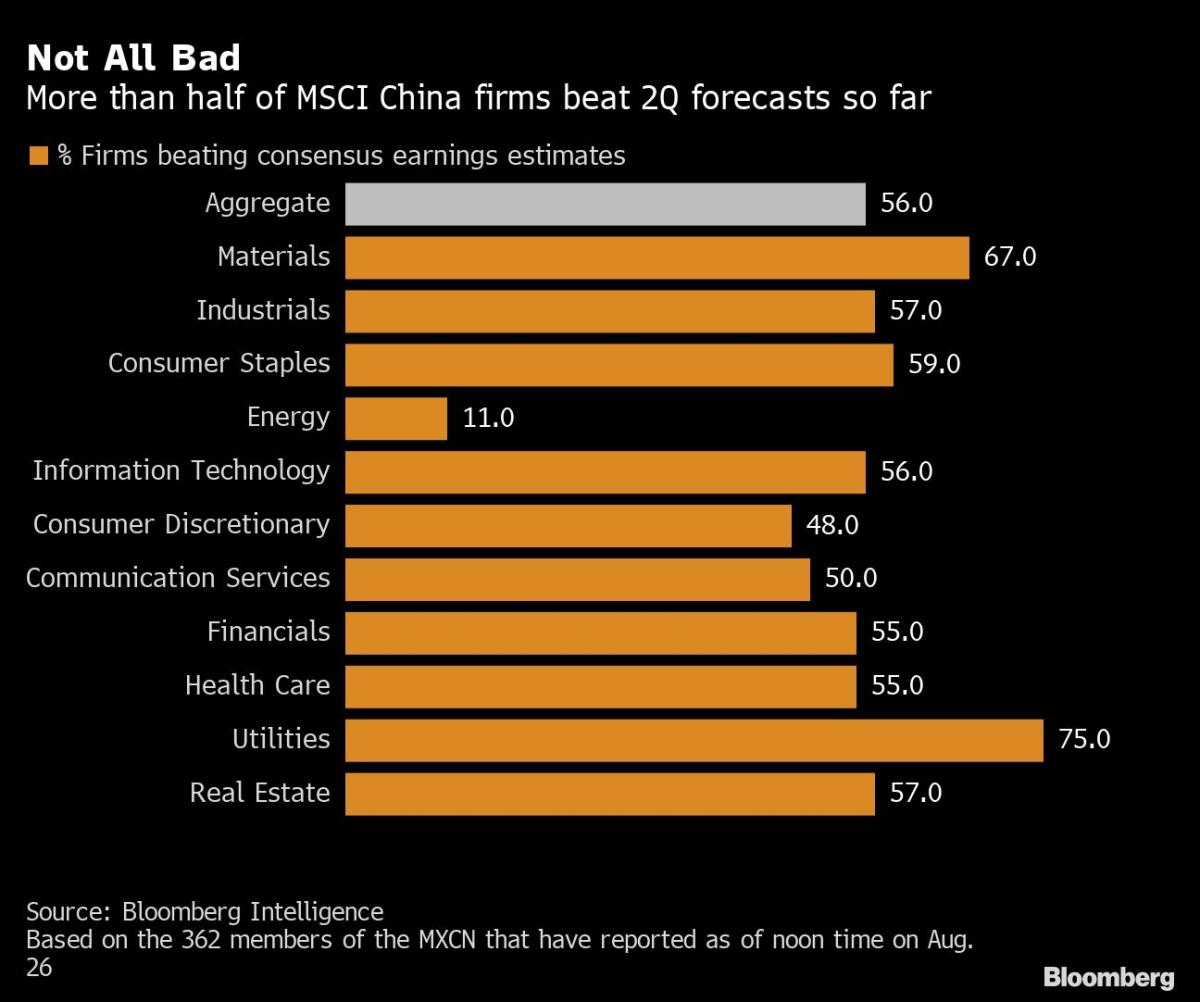(Bloomberg) — Earnings from Chinese firms have shown resilience under harsh lockdowns, but traders are zeroing in on pockets of disappointment and dumping stocks while analysts continue to trim forward estimates.
Most Read from Bloomberg
A number of market heavyweights have seen shares slump after a good earnings show, as investors chose to focus on segment misses or simply used the event as an opportunity to take profit. One striking example was battery giant Contemporary Amperex Technology Co., whose stock slid nearly 6% earlier last week even as a 82% jump in profit trumped estimates.
Aggregate earnings per share have delivered an upward surprise of 9.4% for over half of the 715 MSCI China Index members that have reported second-quarter results, as per calculations by Bloomberg Intelligence. While this could have cheered traders bracing for the worst from a quarter when the economy barely grew, the Chinese gauge is down over 3% in the past month, trailing the Asian benchmark’s rise of almost 1%.
That underscores widespread investor pessimism as concerns ranging from the property crisis to a power shortage and persistent Covid outbreaks cloud the outlook for Chinese equities. Even a policy rate cut and fiscal stimulus measures have failed to lift sentiment.
“These are indeed tough times, and with earnings season wrapping up next week and some of the firms waiting until the last minute to spill the bad news, it’s easy to find any kind of excuse to take profit,” said Wang Mingli, executive director at Shanghai Youpu Investment Co. “For some, there doesn’t seem to be enough reasons to buy.”
Twelve-month forward earnings estimates for the MSCI China gauge are set to fall for a third straight quarter. They are down 1.3% since the end of June, after being cut 9% in the previous three months, data compiled by Bloomberg show.
Market Reaction
Shares of CATL, China’s third-largest stock by market value, just capped their biggest weekly drop since early July as a year-on-year decline in battery margins disappointed investors.
Gaming giant NetEase Inc. slumped more than 6% in Hong Kong on Aug. 19 even as Citigroup analysts called its results a “solid beat,” while WuXi Apptec Co., a healthcare sector bellwether, earlier lost 4.4% post a bigger-than-expected 73% jump in profit.
Similarly, electric-vehicle makers Li Auto Inc. and XPeng Inc. slid despite strong revenue growth that topped estimates, as traders were fixated on conservative delivery guidance for the third quarter.
Thanks to such reactions, there’s not been much of a stock divergence between winners and losers. Overall, firms that beat consensus saw their shares outperform the MSCI China gauge by just one percentage point on average on the first trading day after results, according to Bloomberg Intelligence. That’s versus 1.5 percentage points for the first quarter.
‘Broad-Based Miss’
While earnings for MSCI China have held up well so far, with a heavy tech weighting giving a boost, a Morgan Stanley report showed the number of onshore-listed firms missing consensus is on track to be the biggest since 2018.
Almost 28% of so-called A-share companies that have reported earnings so far have missed consensus, strategists including Fran Chen wrote in a report last week, adding that they see “further room for consensus earnings downward revisions.”
This “broad-based miss” is a clear indication of macro weakness, they wrote.
Share price declines have also been more pronounced for onshore firms. The benchmark CSI 300 Index has fallen 1.5% so far in August, the worst performance among national benchmarks in Asia.
All of this comes against the backdrop of a deteriorating outlook for China’s economy. Economists surveyed by Bloomberg expect 3.7% growth for this year, far below the official 5.5% target and down from 4% at the end of July.
The equities weakness “could also be due to the fact that the impact of stimulus measures so far has been limited,” said Zhao Yuanyuan, a fund manager at Shenzhen Qianhai JianHong Times Asset Management Co. “Macro data suggests it will be difficult to have a sequential improvement in earnings by the third quarter.”
Most Read from Bloomberg Businessweek
©2022 Bloomberg L.P.

















%20(2)%20(1).jpg)


Discussion about this post